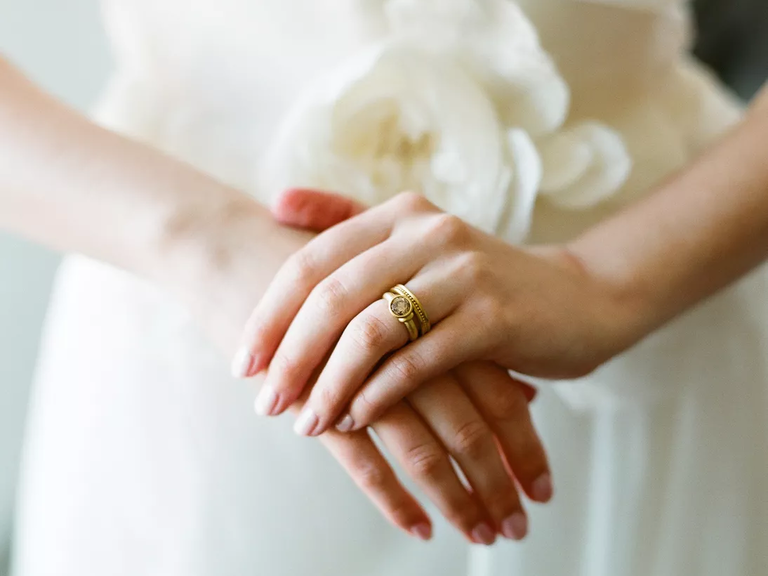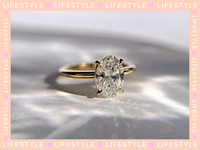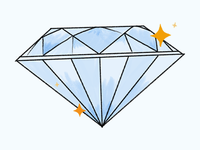What are the Benefits of a Low-Set Engagement Ring? Your Questions Answered
Low-profile engagement rings are an up-and-coming trend, and it's no wonder why. What are the benefits of a low-set engagement ring? They're understated and super practical for everyday wear (which is the whole idea of an engagement ring, anyway). And allow us to myth bust: This category doesn't mean low-profile in the sense of simple or not flashy (on the contrary, low-profile cluster arrangements are a way to pile on the bling). The phrase, also known as low-set, refers to a low-profile engagement ring setting in which the center stone is not raised high off the finger the way a towering solitaire is. The easiest way to tell a low-set ring versus a high-set ring is if the bottom facet—called the culet, and usually pointed—rests inside the band or is fully encased (making it low-profile) or above the band (high-profile). One jewelry designer who does the style exceptionally well is Grace Lee, founder and creative director of the eponymous LA-based brand. Here, she weighs in on the pros and cons of the style; keep scrolling to see other jewelers who specialize in it as well.
In this article:
- What is a Low-Profile Engagement Ring Setting?
- A Low-Set Ring vs. a High-Set Ring
- What Are the Benefits of a Low-Set Engagement Ring?
- What Are the Cons of a Low-Set Engagement Ring?
- Best Diamond Shapes for Low-Set Engagement Rings
- Where to Shop for Low-Set Engagement Rings
What is a Low-Profile Engagement Ring Setting?
Unfortunately for those on the hunt, there aren't necessarily specific measurements attached to low-setting engagement rings, but there are ways to tell if a ring is low-profile. If you're shopping online, make sure the ring has a side view available and gauge based on that (another great indicator is when the ring is photographed on a hand for proportion). Views from the top of the ring can be deceiving; sometimes, the center stone looks embedded in the band, but when you see it from the side, it's actually rising high above.
Next, take a look at the engagement ring setting: If the prongs emerge from the top of the band to hold the diamond, that means it's high-profile. Prongs should start in line with the band in order to be a low-profile engagement ring. Better yet, bezel settings fully encase the gemstone on all sides and typically have a slim, low-profile design. Split-shank bands—where the metal splits in two to support the setting on both sides—can also offer the protection of low-set engagement rings. Lee takes all of this into account when designing. "All of our engagement ring settings are designed to be as low-profile as possible while allowing the culet to clear the finger," she says. "With each custom engagement ring, we take those exact specifications into consideration."
A Low-Set Ring vs. a High-Set Ring
The definition is exactly how it sounds: High-set engagement rings rise high off the finger—think of a basket-set solitaire with a one-carat or larger stone. These rings have an eye-catching wow factor, to be sure, but they can also twist around the finger and snag on clothing, fabrics and other materials.
Low-profile engagement ring settings, on the other hand, sit lower on the finger, creating an almost flat effect. Think bezel-set diamonds or cluster rings. They may or may not have a prominent center stone, but either way, it doesn't rise up too high off the finger.
What Are the Benefits of a Low-Set Engagement Ring?
The most obvious benefit of a low-profile engagement ring is its practicality. It won't catch, snag or otherwise get dinged the way a high-profile solitaire might. Low-profile rings are also great for brides with an active lifestyle. Here are a few more specific pros and cons, as outlined by Lee.
Practicality
"High-profile settings are often cumbersome for the wearer and are more likely to catch on things like clothing," Lee says. "A low-profile setting is more fitting for modern life and less likely to catch on things." If you work with your hands, carry heavy objects (even grocery bags!) or take gloves on and off often as a doctor or chef, a low-profile setting can be a great choice for you.
Stone Protection
Low-profile engagement rings can be just as blingy as high-profile ones—and they'll hold their sparkle longer between cleanings. Low-profile diamond engagement rings are not as exposed to the elements as high-profile stones, so the diamond stays cleaner and sparklier for longer.
Stability
High-rise solitaires are, naturally, unbalanced, with a weighted stone on top and nothing underneath; this effect is exacerbated with thinner bands. They often fall to the side or twist around the finger. Low-set engagement rings, on the other hand, have a bit more stability. They sit closer to the finger and twist around less, meaning the focal point always remains on top of the finger—and therefore top of mind.
What Are the Cons of a Low-Set Engagement Ring?
Just as with any other element of the engagement ring, choosing between a high and low setting is a matter of personal preference. But it's important to know the good and bad of each selection. Here are a couple downsides to low-set engagement rings.
Smaller Diamonds
"As the carat weight of a diamond increases, so does the depth," Lee says, indicating that low-profile settings often don't accommodate really large diamonds. But fear not. "Even with a traditional cut diamond with a culet, you can choose proportions to maximize the face of the diamond without sacrificing brilliance that comes from the depth." You can also explore cluster settings that incorporate a group of small diamonds on an even plane to create the illusion of something larger.
Difficult Band Matching
Since they sit low to your hand, low-profile rings can be harder to pair with a wedding band; high-profile rings offer room for the wedding bands to sit flush against them. That said, most jewelers will customize something that works well even with a low-profile engagement ring. Lee makes it a point. "Our custom settings, while being as low profile to the hand as possible, still allow for a wedding band to sit completely flush next to them," the designer says.
Best Diamond Shapes for Low-Set Engagement Rings
You can certainly lean into the inherent minimalism and understated style of low-profile engagement rings if that's what you're after—but if you're looking for something that's both blingy and practical, you do have options. "[Look for] rose cut diamonds, which have a flat back that innately allows for a lower profile setting," Lee says. "However, we can also achieve a low profile setting with a traditional diamond that has a traditional culet." Low profile bezel set engagement rings can accommodate almost all diamond shapes—oval, emerald, round, you name it—as can cluster arrangements. We love a low-profile cluster of various stone shapes for something with an antique bent but bold design.
Where to Shop for Low-Set Engagement Rings
As the trend ramps up, we expect to see many top jewelers embracing low-profile design; but already, there are a handful of stellar jewelers doing it well.
Grace Lee: Our expert jeweler is a master of the low-profile setting. The unique placement of diamonds in her signature styles is strategic: It creates horizontal, rather than vertical, depth that's flush with the finger. Check out her double ring with three diamonds or, for a wider-band look, the Demi Demi Plus.
Ashley Zhang: This designer offers creative takes on the concept and often infuses color to boot. But even if you're looking for something more traditional, you can find it in a low-profile version here. Zhang's Old Mine three-stone ring is a stunning low-set iteration of a classic, while the Edwardian opal ring is entirely unique.
Clean Origin: If sustainability and conflict-free diamonds are a priority, check out this jeweler, which offers a wide selection of engagement rings with both high and low profiles. It was founded by a third-generation jeweler who knows how to pile on the bling even with practical low-set styles (see: the Mozart Grand bridal set).
Berlinger: LA-based Berlinger Jewelry is a must-shop for vintage-leaning brides; the designs have art deco inspiration with modern twists. Designer Michelle Berlinger is best known for her diamond mosaic pieces, which feature numerous diamonds of varying shapes on an even plane—promising lots of sparkle in a low setting. Plus, her pieces are customizable, so you can make them uniquely yours.
Kinn: Kinn is a go-to for low-set engagement rings, offering unique pieces with a focus on not just the stone but the gold or metal encasing it. Its bestselling Solis ring comes in varying widths and with all different diamond shapes, but its main feature is the cool ribbed band. We also love the Eloise, featuring an east-west diamond encased in organically molded metal.
Melanie Casey: Cluster rings are a great way to up the sparkle factor in a low-profile setting—and they're Melanie Casey's specialty. (The Diamond Indie ring features seven diamonds in a secure closed basket setting.) Casey is also a master of minimalism, offering many low-set solitaire engagement rings such as the bezel Edifice ring.





















